Modelling Sustainable Industrial Symbiosis
Abstract
1. Introduction
2. Materials and Methods
2.1. Literature Review
2.2. Model
3. Results
3.1. Case Study
3.2. Implementation
- Three energy businesses (energy sector)
- Three agriculture businesses (agriculture sector)
3.2.1. Identifying Symbiosis
3.2.2. Quantitative Assessment
3.2.3. Optimal Assessment
4. Discussion
4.1. System’s Boundary
4.2. Implementation and Results
4.3. Use of the Method on Other System
5. Conclusions
Author Contributions
Funding
Institutional Review Board Statement
Informed Consent Statement
Data Availability Statement
Acknowledgments
Conflicts of Interest
References
- A European Green Deal. Available online: https://ec.europa.eu/info/strategy/priorities-2019-2024/european-green-deal_en (accessed on 2 February 2021).
- Bocken, N.M.P.; Short, S.W.; Rana, P.; Evan, S. A literature and practice review to develop sustainable business model archetypes. J. Clean. Prod. 2014, 65, 42–56. [Google Scholar] [CrossRef]
- Azapagic, A. Systems approach to corporate sustainability. A General Management Framework. Process Saf. Environ. Prot. 2003, 81, 303–316. [Google Scholar] [CrossRef]
- Benedetto, L.D.; Klemes, J. The Environmental Performance Strategy Map: An integrated LCA approach to support the strategic decision-making process. J. Clean. Prod. 2009, 17, 900–906. [Google Scholar] [CrossRef]
- Benoît, C.; Norris, G.A.; Valdivia, S.; Ciroth, A.; Moberg, A.; Prakash, U.B.S.; Ugaya, C.; Beck, T. The guidelines for social life cycle assessment of products: Just in time! Int. J. Life Cycle Assess. 2010, 15, 156–163. [Google Scholar] [CrossRef]
- Benoît-Norris, C.; Vickery-Niederman, G.; Valdivia, S.; Franze, J.; Traverso, M.; Ciroth, A.; Mazijn, B. Introducing the UNEP/SETAC methodological sheets for subcategories of social LCA. Int. J. Life Cycle Assess. 2011, 16, 682–690. [Google Scholar] [CrossRef]
- Domenech, T.; Bleischwitz, R.; Doranova, A.; Panayotopoulos, D.; Roman, L. Mapping Industrial Symbiosis Development in Europe_ typologies of networks, characteristics; performance and contribution to the Circular Economy. Resour. Conserv. Recycl. 2019, 141, 76–98. [Google Scholar] [CrossRef]
- Domenech, T.; Davies, M. Structure and morphology of industrial symbiosis networks: The case of Kalundborg. Procedia Soc. Behav. Sci. 2011, 10, 79–89. [Google Scholar] [CrossRef]
- Angren, J.; Arnoldsson, J.; Arvidsson, J.; Baumgarten, S.; Dijkstra, S.; Högström, C.; Mårtensson, C.; Nilsson, M.; Pettersson, D.; Rehn, S. Exploring the Industrial Symbiosis in Lidköping; University of Linköping: Linköping, Sweden, 2012. [Google Scholar]
- Allard, V.; Broberg, N.; Danielsson, E.; Elmtoft, E.; Lindström, G.; Nelénius, M.; Ohlander, C.; Samuelsson, K.; Torgnysson, E.; Wallberg, R.; et al. Industry Park of Sweden. Project in TKMJ38–Industrial Symbiosis. 2012. Available online: https://www.google.com/url?sa=t&rct=j&q=&esrc=s&source=web&cd=&ved=2ahUKEwjhtIu6r__uAhWEKs0KHayZCWcQFjAAegQIARAD&url=http%3A%2F%2Fwww.industriellekologi.se%2Fdocuments%2FIPOS.pdf&usg=AOvVaw1SiIZ5qZbQAY0bjIdabbp_ (accessed on 28 July 2020).
- Albertsson, A.; Jónsson, J. The svartsengi resource park. In Proceedings of the World Geothermal Congress, Bali, Indonesia, 25–29 April 2010. [Google Scholar]
- Baas, L. Industrial Symbiosis in the Rotterdam Harbour and Industry Complex: Reflections on the Interconnection of the Techno-Sphere with the Social System. Bus. Strategy Environ. 2008, 17, 330–340. [Google Scholar] [CrossRef]
- Cecelja, F.; Raafat, T.; Trokanas, N.; Innes, S.; Smith, M.; Yang, A.; Zorgios, Y.; Korkofygas, A.; Kokossis, A. e-Symbiosis: Technology-enabled support for Industrial Symbiosis targeting Small and Medium Enterprises and innovation. J. Clean. Prod. 2015, 98, 336–352. [Google Scholar] [CrossRef]
- Aparisi, T.A.D. Social Aspects of Industrial Symbiosis Networks; Bartlett School of Graduate Studies, University College London: London, UK, 2010. [Google Scholar]
- Paquin, R.L.; Busch, T.; Tilleman, S.G. Creating Economic and Environmental Value through Industrial Symbiosis. Long Range Plan. 2015, 48, 95–107. [Google Scholar] [CrossRef]
- Jacobsen, N.B. Industrial Symbiosis in Kalundborg; Denmark: A Quantitative assessment of Economic and Environmental Aspects. J. Ind. Ecol. 2006, 10, 1–2. [Google Scholar] [CrossRef]
- Daddi, T.; Nucci, B.; Iraldo, F. Using Life Cycle Assessment (LCA) to measure the environmental benefits of industrial symbiosis in an industrial cluster of SMEs. J. Clean. Prod. 2017, 147, 157–164. [Google Scholar] [CrossRef]
- Chun, Y.; Lee, K. Life Cycle-Based Generic Business Strategies for Sustainable Business Models. J. Sustain. Dev. 2013, 6, 1913–9063. [Google Scholar] [CrossRef]
- Daddi, T.; Nucci, B.; Iraldo, F.; Testa, F. Enhancing the Adoption of Life Cycle Assessment by Small and Medium Enterprises Grouped in an Industrial Cluster A Case Study of the Tanning Cluster in Tuscany (Italy). J. Ind. Ecol. 2015, 20, 5. [Google Scholar] [CrossRef]
- Jørgensen, A.; Bocq, A.L.; Nazarkina, L.; Hauschild, M. Methodologies for Social Life Cycle Assessment. Int. J. LCA 2008, 13, 96–103. [Google Scholar] [CrossRef]
- Schwarz, E.J.; Steininger, K.W. Implementing nature’s lesson: The industrial recycling network enhancing regional development. J. Clean. Prod. 1997, 5, 47–56. [Google Scholar] [CrossRef]
- Posch, A. Industrial Recycling Networks as Starting Points for Broader Sustainability-Oriented Cooperation? J. Ind. Ecol. 2010, 14, 242–257. [Google Scholar] [CrossRef]
- Joyce, A.; Paquin, R.L. The triple-layered business model canvas: A tool to design more sustainable business models. J. Clean. Prod. 2016, 135, 1474–1486. [Google Scholar] [CrossRef]
- Transforming Our World: The 2030 Agenda for Sustainable Development. Available online: https://sdgs.un.org/2030agenda (accessed on 1 February 2021).
- Fonseca, L.M.; Domingues, J.P.; Dima, A.M. Mapping the Sustainable Development Goals Relationships. Sustainability 2020, 12, 3359. [Google Scholar] [CrossRef]
- Zimon, D.; Tyan, J.; Sroufe, R. Implementing Sustainable Supply Chain Management: Reactive, Cooperative, and Dynamic Models. Sustainability 2019, 11, 7227. [Google Scholar] [CrossRef]
- Khan, A.S.; Salah, B.; Zimon, D.; Ikram, M.; Khan, R.; Pruncu, C.I. A Sustainable Distribution Design for Multi-Quality Multiple-Cold-Chain Products: An Integrated Inspection Strategies Approach. Energies 2020, 13, 6612. [Google Scholar] [CrossRef]
- Mattila, T.J.; Pakarinen, S.; Sokka, L. Quantifying the total environmental impacts of an industrial symbiosis—A comparison of process; hybrid and input-output life cycle assessment. Environ. Sci. Technol. 2010, 44, 4309–4314. [Google Scholar] [CrossRef] [PubMed]
- Martin, M.; Eklund, M. Improving the environmental performance of biofuels with industrial symbiosis. Biomass Bioenergy 2011, 35, 1747–1755. [Google Scholar] [CrossRef]
- Berkel, R.V. Quantifying Sustainability Benefits of Industrial Symbioses. J. Ind. Ecol. 2010, 14, 371–373. [Google Scholar] [CrossRef]
- Environmental Management-Life Cycle Assessment-Principles and Framework. Environmental Management-LIFE Cycle Assessment-Requirements and Guidelines; ISO 14040:2006; ISO: Geneva, Switzerland, 2006.
- International Reference Life Cycle Data System Handbook. General Guide for Life Cycle Assessment—Detailed Guidance; European Commission, Joint Research Centre, Institute for Environment and Sustainability: Ispra, Italy, 2010.
- Dong, L.; Fujita, T.; Zhang, H.; Dai, M.; Fujii, M.; Ohnishi, S.; Geng, Y.; Liu, Z. Promoting low-carbon city through industrial symbiosis: A case in China by applying HPIMO model. Energy Policy 2013, 61, 864–873. [Google Scholar] [CrossRef]
- Dong, L.; Liang, H.; Zhang, L.; Liu, Z.; Gao, Z.; Hu, M. Highlighting regional eco-industrial development: Life cycle benefits of an urban industrial symbiosis and implications in China. Ecol. Model. 2017, 361, 164–176. [Google Scholar] [CrossRef]
- Suh, S.; Huppes, G. Methods for Life Cycle Inventory of a product. J. Clean. Prod. 2005, 13, 687–697. [Google Scholar] [CrossRef]
- Sokka, L.; Lehtoranta, S.; Nissinen, A.; Melanen, M. Analyzing the Environmental Benefits of Industrial Symbiosis Life Cycle Assessment Applied to a Finnish Forest Industry Complex. J. Ind. Ecol. 2010, 15, 137–155. [Google Scholar] [CrossRef]
- Sokka, L. Local Systems. Global Impacts Using Life Cycle Assessment to Analyse the Potential and Constraints of Industrial Symbioses; Faculty of Biological and Environmental Sciences, University of Helsinki: Helsinki, Finland, 2011. [Google Scholar]
- Kerdlap, P.; Low, J.S.C.; Tan, D.Z.L.; Yeo, Z.; Ramakrishna, S. M3-IS-LCA: A Methodology for Multi-level Life Cycle Environmental Performance Evaluation of Industrial Symbiosis Networks. Resour. Conserv. Recycl. 2020, 161, 104963. [Google Scholar] [CrossRef]
- Dong, L.; Fujita, T.; Dai, M.; Geng, Y.; Ren, J.; Fujii, M.; Wang, Y.; Ohnishi, S. Towards preventative eco-industrial development: An industrial and urban symbiosis case in one typical industrial city in China. J. Clean. Prod. 2016, 114, 387–400. [Google Scholar] [CrossRef]
- Aissani, L.; Lacassagne, A.; Bahers, J.; Féon, S.L. Life cycle assessment of industrial symbiosis: A critical review of relevant reference scenarios. J. Ind. Ecol. 2019, 23, 972–985. [Google Scholar] [CrossRef]
- Røyne, F.; Berlin, J.; Ringström, E. Life cycle perspective in environmental strategy development on the industry cluster level: A case study of five chemical companies. J. Clean. Prod. 2015, 86, 125–131. [Google Scholar] [CrossRef]
- Hildebrandt, J.; O’Keeffe, S.; Bezama, A.; Thran, D. Revealing the Environmental Advantages of Industrial Symbiosis in Wood-Based Bioeconomy Networks: An Assessment from a Life Cycle Perspective. J. Ind. Ecol. 2018, 23, 808–822. [Google Scholar] [CrossRef]
- Maria, A.D.; Salman, M.; Dubois, M.; Acker, K.V. Life cycle assessment to evaluate the environmental performance of new construction material from stainless steel slag. Build. Compon. Build. 2018, 23, 2091–2109. [Google Scholar] [CrossRef]
- Mattila, T.; Lehtoranta, S.; Sokka, L.; Melanen, M.; Nissinen, A. Methodological Aspects of Applying Life Cycle Assessment to Industrial Symbioses. J. Ind. Ecol. 2012, 16, 51–60. [Google Scholar] [CrossRef]
- Martin, M.; Svensson, N.; Eklund, M. Who gets the benefits? An approach for assessing the environmental performance of industrial symbiosis. J. Clean. Prod. 2015, 98, 263–271. [Google Scholar] [CrossRef]
- Afshari, H.; Tosarkani, B.M.; Jaber, M.Y.; Searcy, C. The effect of environmental and social value objectives on optimal design in industrial energy symbiosis: A multi-objective approach. Resour. Conserv. Recycl. 2020, 158, 104825. [Google Scholar] [CrossRef]
- Short, W.; Packey, D.J.; Holt, T. A Manual for Economic Evaluation of Energy Efficiency and Renewable Energy Technologies; National Renewable Energy Laboratory, A National Laboratory of the U.S. Department of Energy: Golden, CO, USA, 1995. [Google Scholar]
- Martinez-Sanchez, V.; Kromann, M.A.; Astrup, T.F. Life cycle costing of waste management systems: Overview; calculation principles and case studies. Waste Manag. 2015, 36, 343–355. [Google Scholar] [CrossRef]
- Timonen, K.; Harrison, E.; Katajajuuri, J.; Kurppa, S. Environmental cost accounting methodologies. In Natural Resources and Bioeconomy Studies; Natural Resource Institute Finland: Helsinki, Finland, 2017. [Google Scholar]
- Manríquez-Altamirano, A.; Sierra-Pérez, J.; Muñoz, P.; Gabarrell, X. Analysis of urban agriculture solid waste in the frame of circular economy: Case study of to-mato crop in integrated rooftop greenhouse. Sci. Total Environ. 2020, 734, 139375. [Google Scholar] [CrossRef] [PubMed]
- Haq, H.; Valisuo, P.; Kumpulainen, L.; Tuomi, V.; Niemi, S. A preliminary assessment of industrial symbiosis in Sodankylä. Curr. Res. Environ. Sustain. 2020, 2, 100018. [Google Scholar] [CrossRef]
- Alaraudanjoki, J. Realizing Bioeconomy in the North of Finland: Design of a Co-digester for the Municipality of Sodankylä. Master’s Thesis, Environmental Engineering, University of Oulu, Oulu, Finland, 2016. [Google Scholar]
- Smetana, S.; Schmitt, E.; Mathys, A. Sustainable use of Hermetia illucens insect biomass for feed and food: Attributional and consequential life cycle assessment. Resour. Conserv. Recycl. 2019, 144, 285–296. [Google Scholar] [CrossRef]
- Lapland Consortium of Municipalities. Available online: https://lapeco.fi/ (accessed on 28 July 2020).
- Fuel Classification. Available online: http://tilastokeskus.fi/tup/khkinv/khkaasut_polttoaineluokitus.html (accessed on 28 July 2020).
- Taxing Energy Use 2019, Using Taxes for Climate Action. Available online: http://www.oecd.org/tax/taxing-energy-use-efde7a25-en.htm (accessed on 28 July 2020).
- Intergovernmental Panel on Climate Change. Emission Factor Database. Available online: https://www.ipcc-nggip.iges.or.jp/EFDB/find_ef.php?ipcc_code=4.C.1&ipcc_level=2. (accessed on 22 December 2020).
- Alejandro, P.; Boer, I.J.M.D.; Gerrits, W.J.J.; Loon, J.J.A.V.; Heetkamp, M.J.W.; Schelt, J.V.; Bolhuis, J.E.; Zanten, H.H.E.V. Bioconversion efficiencies, greenhouse gas and ammonia emissions during black soldier fly rearing eA mass balance approach. J. Clean. Prod. 2020, 271, 122488. [Google Scholar]

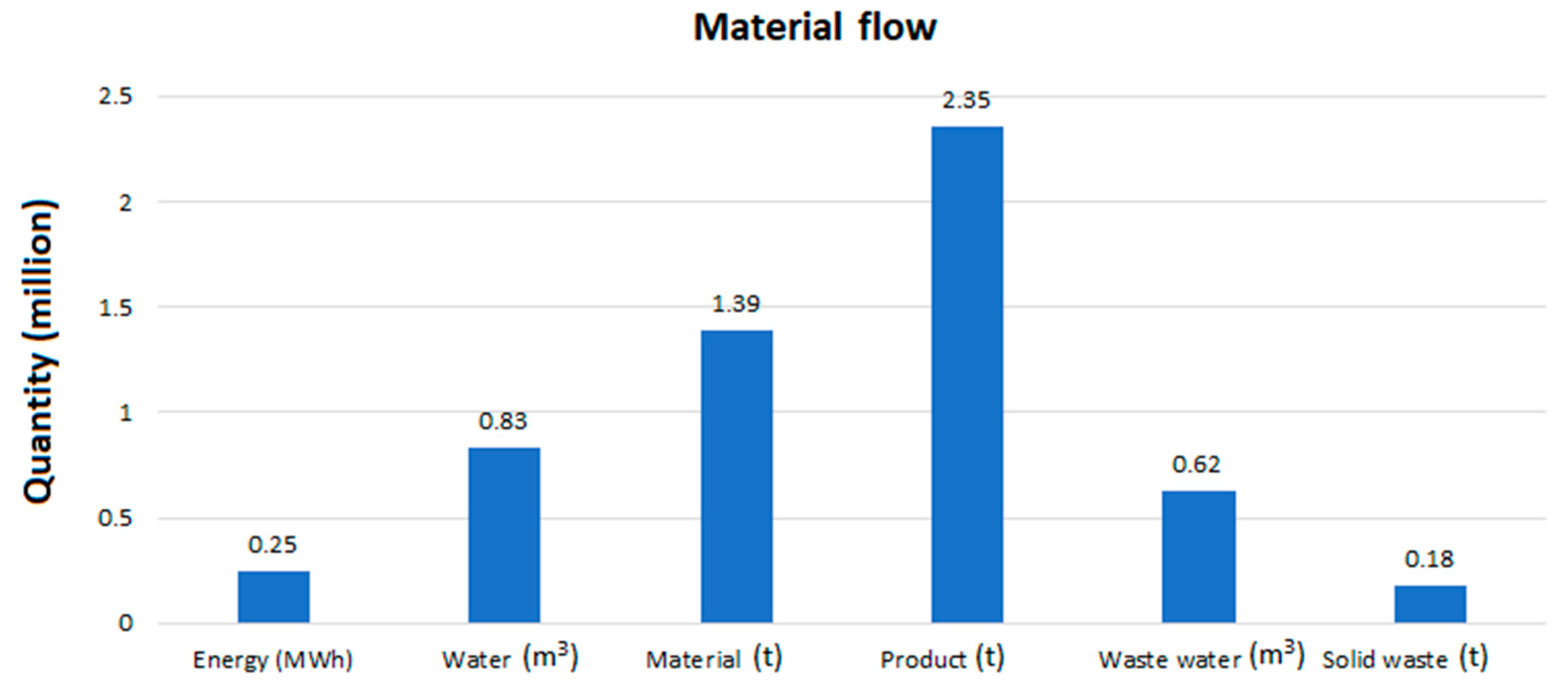
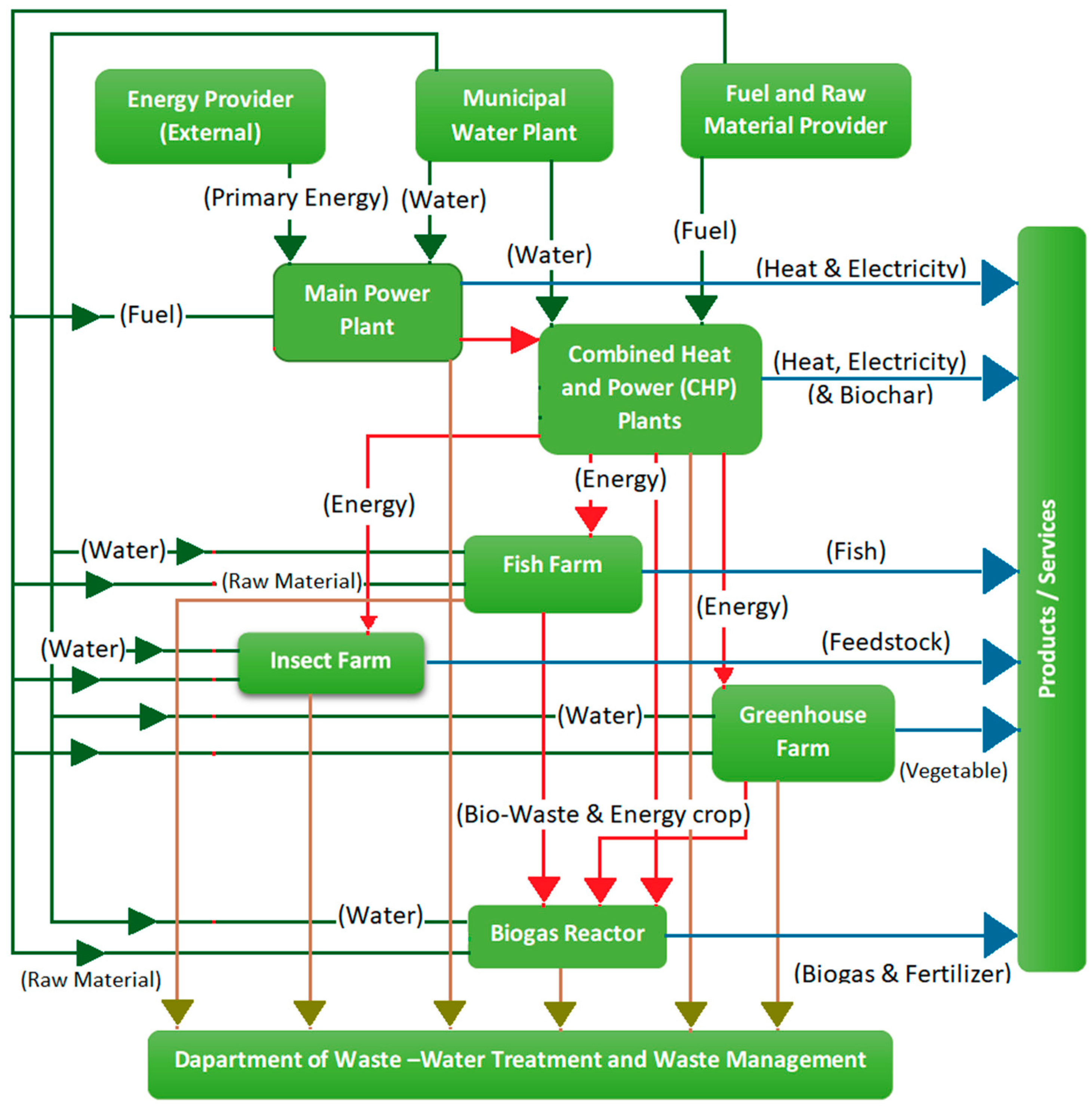
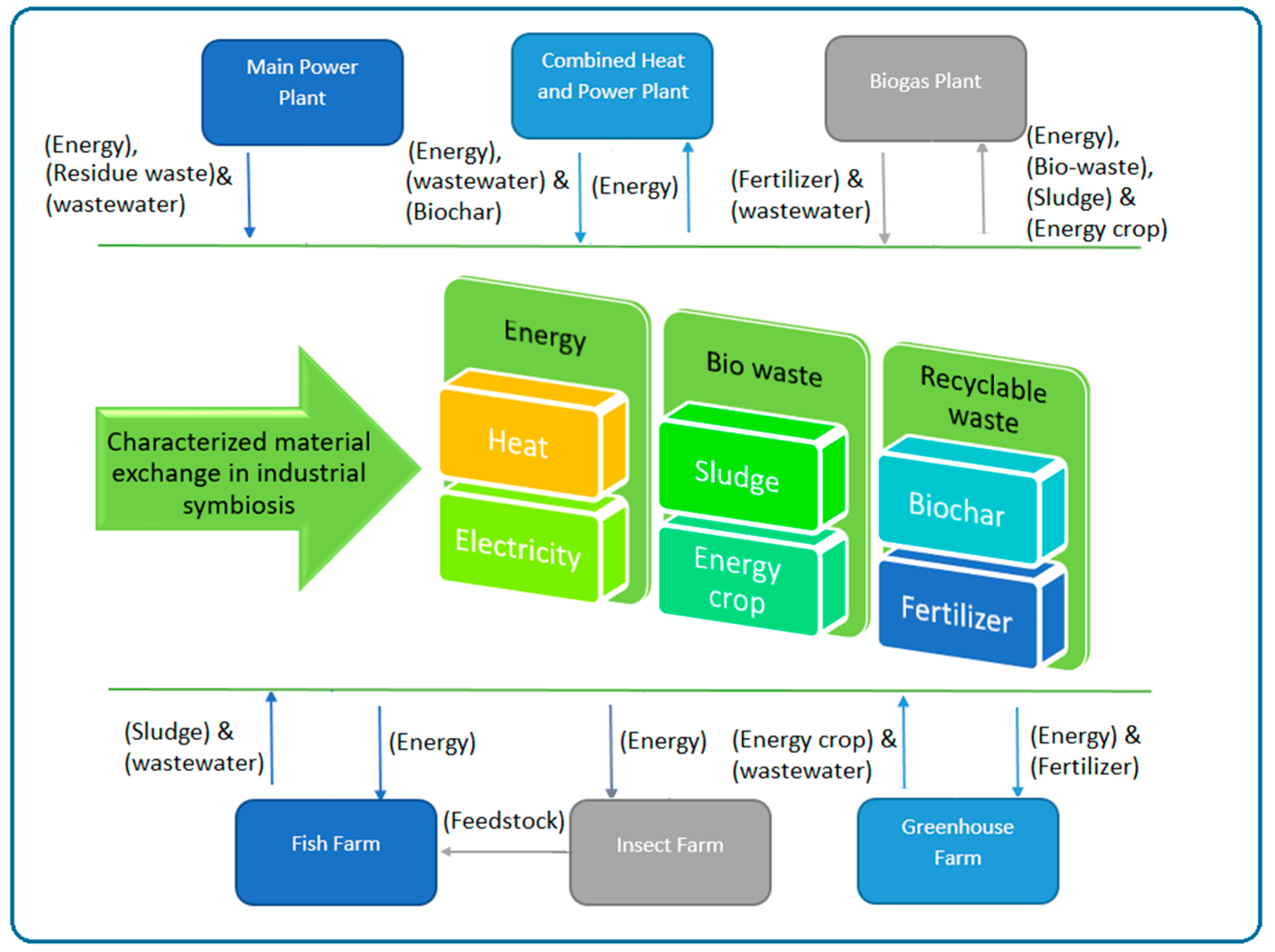
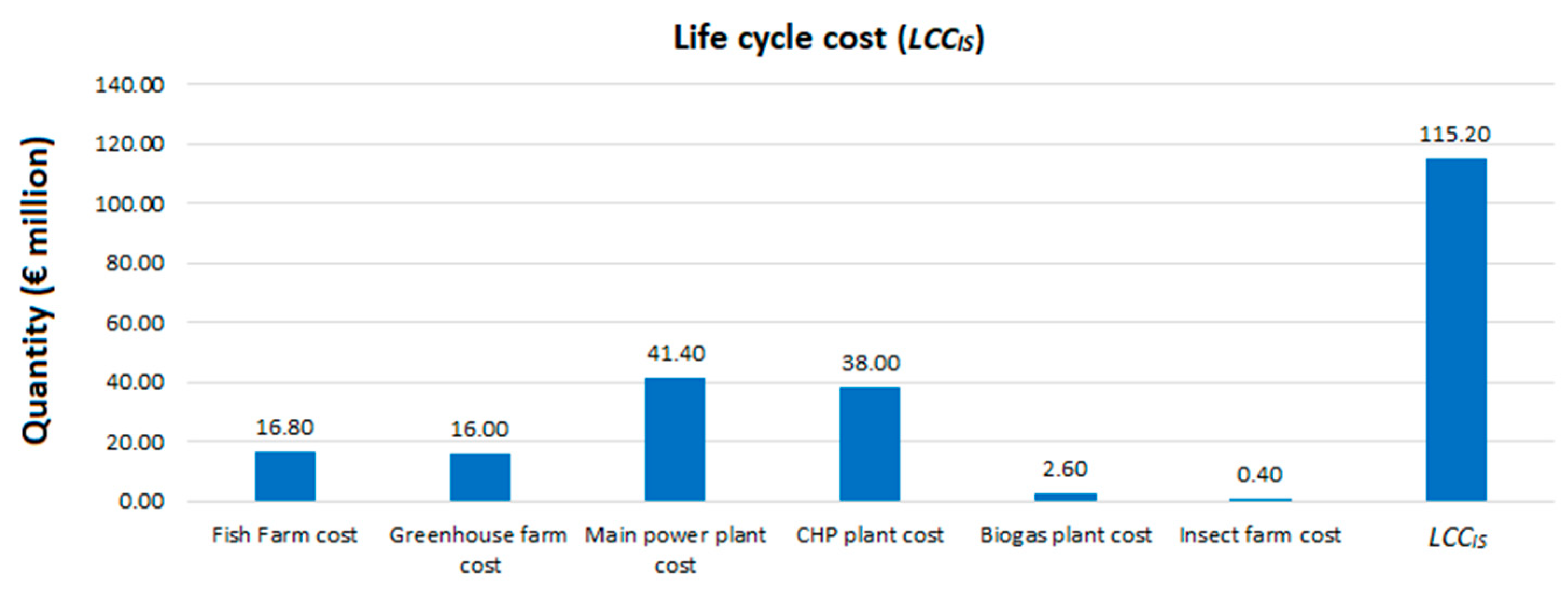
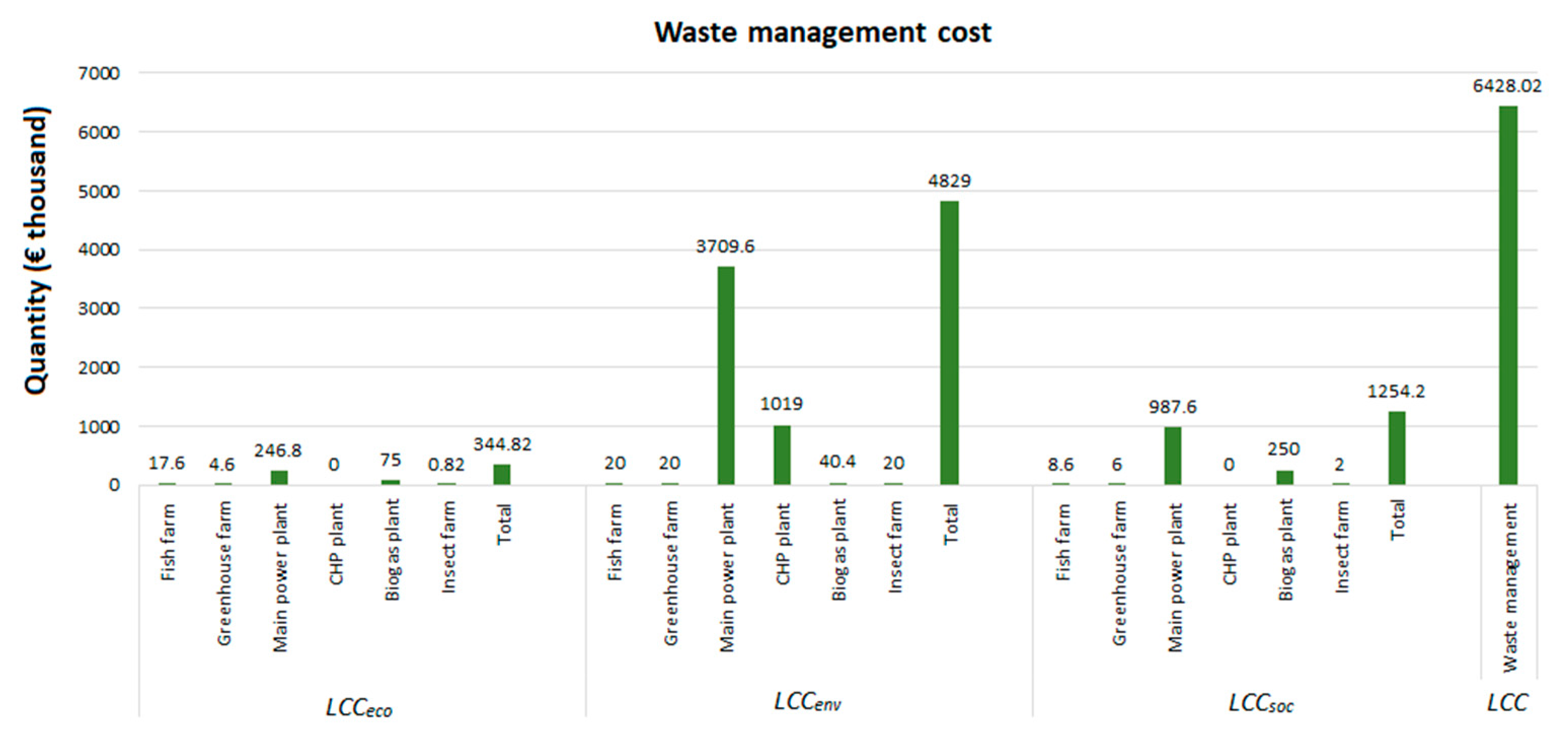
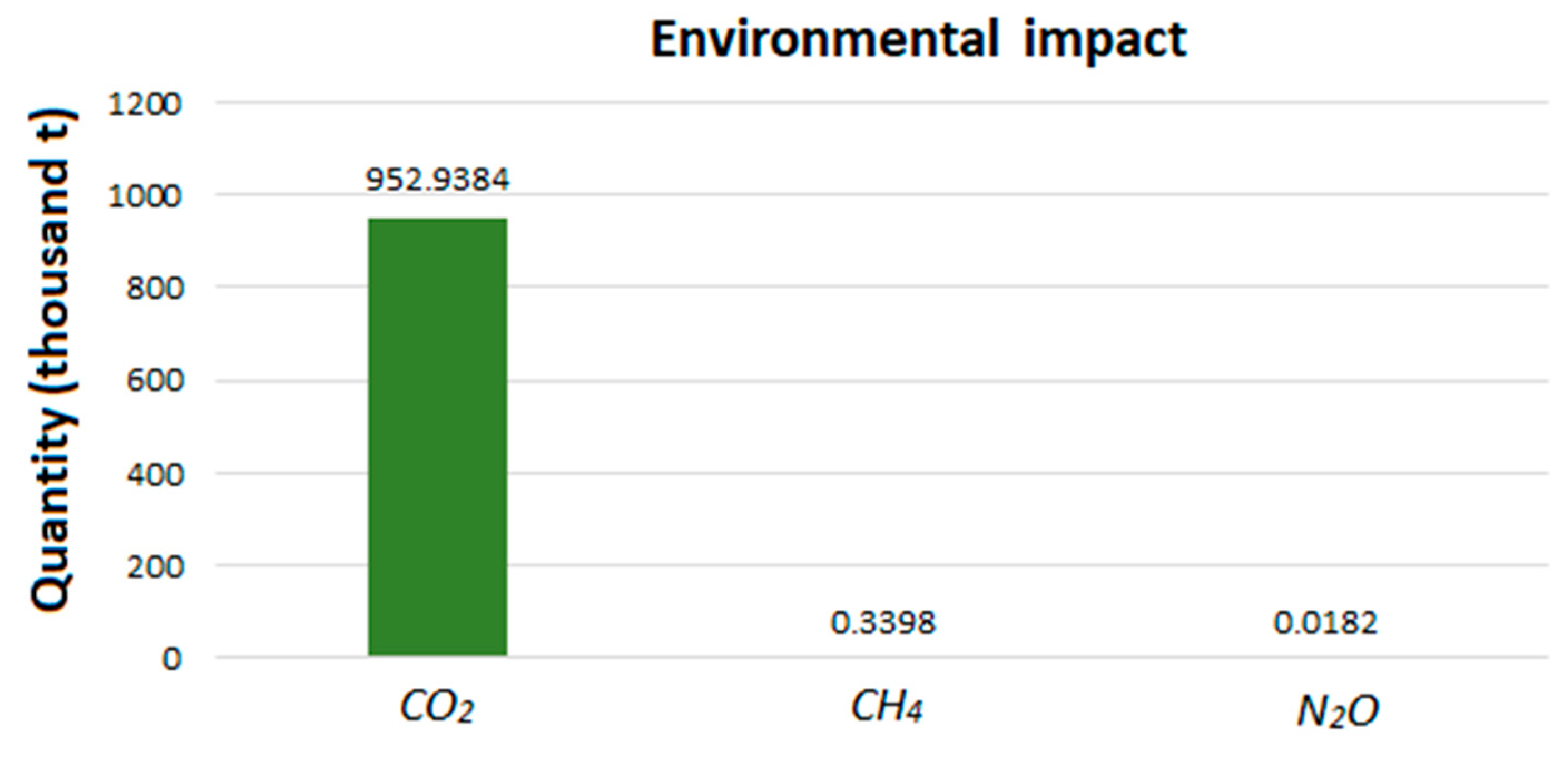
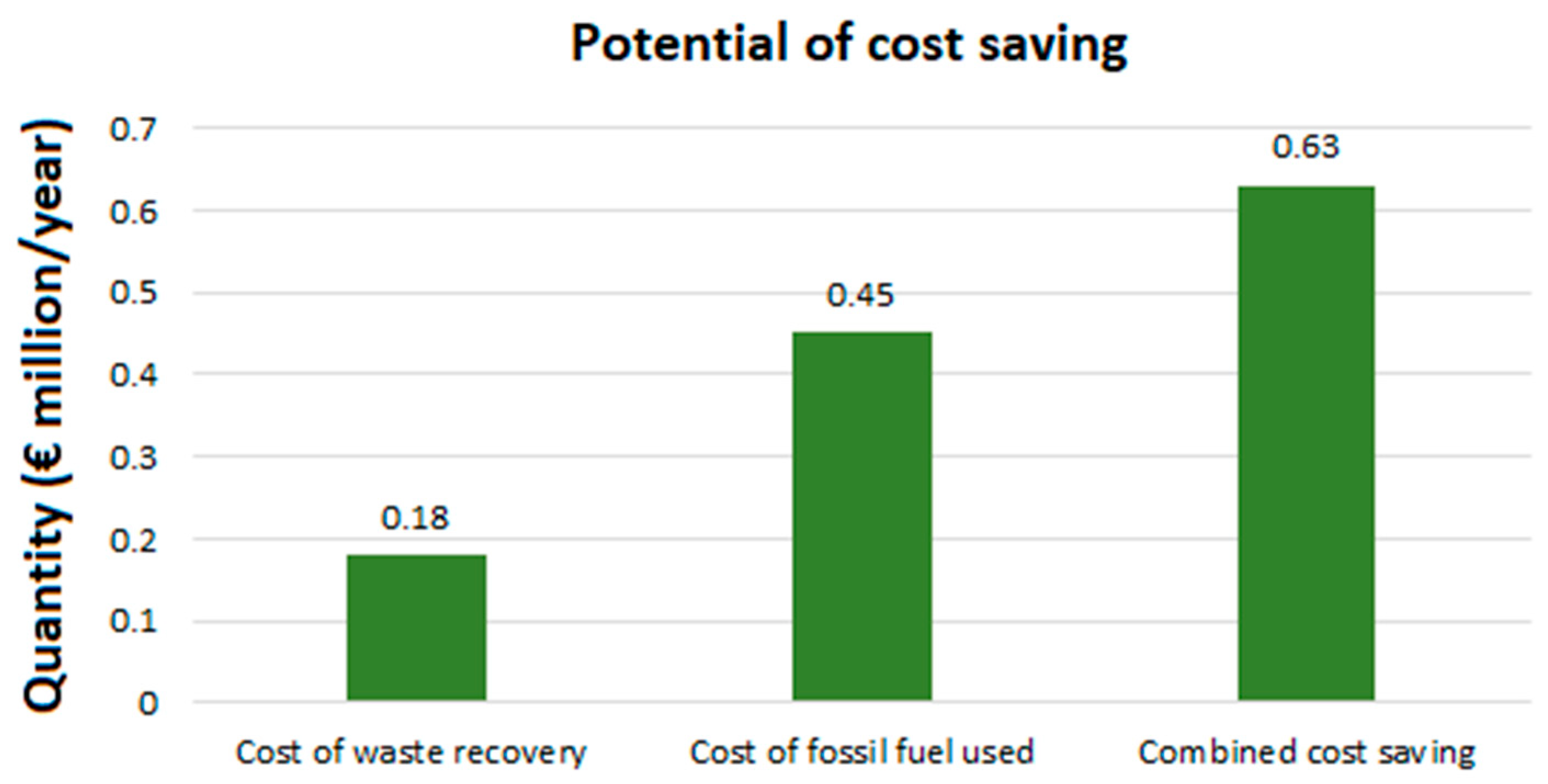
| Parameter | Main Power Plant | CHP Plants | Greenhouse Farm | Fish Farm | Insect Farms | Biogas Reactor |
|---|---|---|---|---|---|---|
| Functional unit | Heat, electricity | Heat | Tomatoes | White fish | Feed stock | Biogas |
| Energy (MWh) | 1840 1 | 3372 1 | 4380 3 | 501 1 | 17 2 | 2216.28 4 |
| Water (m3) | - | - | 6132 3 | 35,040 1 | 218.57 2 | - |
| Material (t) | 54,686.60 1 | 8574 1 | 560 3 | 82.43 1 | 40 2 | 2742.5 4 |
| Product | 86,899 1 (MWh) | 27,900 1 (MWh) | 350 3 (t) | 70 1 (t) | 1.43 2 (t) | 2505.22 4 (t) |
| Waste water (m3) | - | - | - | 31,010.40 1 | 216.30 2 | - |
| Solid waste (t) | 8230.70 1 | - | 213.50 3 | 437.12 1 | 25.26 2 | - |
| Industry | Main Power Plant | CHP Plants | Greenhouse Farm | Fish Farm | Insect Farms | Biogas Reactor |
|---|---|---|---|---|---|---|
| Main Power Plant | 1 | 1 | 0 | 0 | 0 | 0 |
| CHP Plants | 1 | 1 | 1 | 1 | 1 | 1 |
| Greenhouse Farm | 0 | 1 | 1 | 0 | 0 | 1 |
| Fish Farm | 0 | 1 | 0 | 1 | 1 | 1 |
| Insect Farms | 0 | 1 | 0 | 1 | 1 | 0 |
| Biogas Reactor | 0 | 1 | 1 | 1 | 0 | 1 |
| Parameter | Cost of Material (€/year) | Cost of Water Consumption (€/year) | Cost of Energy Consumption (€/year) |
|---|---|---|---|
| Main Power Plant | 1.80 1 million | - | 73.60 1 thousand |
| CHP Plants | 0.78 1 million | - | 0.13 1 million |
| Greenhouse Farm | 0.40 3 million | 6.99 3 thousand | 0.20 3 million |
| Fish Farm | 0.78 1 million | 40 1 thousand | 16.67 1 million |
| Insect Farms | 12 1 thousand | 0.25 1 thousand | 0.68 1 thousand |
| Biogas Feactor | 2.40 2 thousand | - | 88 2 thousand |
| Industry | Waste Type | Waste Product/by-Product (t/year) | Waste Handling Cost |
|---|---|---|---|
| Fish Farm | Economic | 438 1 | 2 1 (€/t) |
| Environmental | 31,063 1 | 1000 2 (€) | |
| Societal | 438 1 | 1 3 (€/t) | |
| Greenhouse Farm | Economic | 154.35 4 | 1.50 3 (€/t) |
| Environmental | - | 1000 2 (€) | |
| Societal | 154.35 3 | 2 3 (€/t) | |
| Main power Plant | Economic | 8230.69 1 | 1.50 3 (€/t) |
| Environmental | 24,682.11 5 | 35 7 (€/t) | |
| Societal | 8230.69 1 | 6 3 (€/t) | |
| CHP Plant | Economic | - | - |
| Environmental | 1019 5 | 5 3 (€/t) | |
| Societal | - | - | |
| Biogas Reactor | Economic | 2500 6 | 1.50 3 (€/t) |
| Environmental | 402.50 5 & 6 | 5 5 (€/t) | |
| Societal | 2500 6 | 5 3 (€/t) | |
| Insect Farm | Economic | 20.95 8 | 2 1 (€/t) |
| Environmental | 216.30 8 | 1.82 1 (€/t) | |
| Societal | 20.95 8 | 5 3 (€/t) |
| Parameter | Main Power Plant | CHP Plants | Greenhouse Farm | Fish Farm | Insect Farms | Biogas Reactor |
|---|---|---|---|---|---|---|
| CO2 (t) | 30,880.94 1 | 14,861.76 1 | 595 4 | 1309 2 | 0.21 3 | - |
| CH4 (t) | 15.64 1 | 1.35 1 | - | - | 216.30 3 | - |
| N2O (t) | 0.62 1 | 0.27 1 | - | - | 25.26 3 | 0.014 1 |
| Parameter | Value | Cost |
|---|---|---|
| Excess Heat | 1.53 MW | 55 (€/MWh) |
| Fossil Fuel Emission | 18,000 tCO2 | 25 (€/tCO2) |
Publisher’s Note: MDPI stays neutral with regard to jurisdictional claims in published maps and institutional affiliations. |
© 2021 by the authors. Licensee MDPI, Basel, Switzerland. This article is an open access article distributed under the terms and conditions of the Creative Commons Attribution (CC BY) license (http://creativecommons.org/licenses/by/4.0/).
Share and Cite
Haq, H.; Välisuo, P.; Niemi, S. Modelling Sustainable Industrial Symbiosis. Energies 2021, 14, 1172. https://doi.org/10.3390/en14041172
Haq H, Välisuo P, Niemi S. Modelling Sustainable Industrial Symbiosis. Energies. 2021; 14(4):1172. https://doi.org/10.3390/en14041172
Chicago/Turabian StyleHaq, Hafiz, Petri Välisuo, and Seppo Niemi. 2021. "Modelling Sustainable Industrial Symbiosis" Energies 14, no. 4: 1172. https://doi.org/10.3390/en14041172
APA StyleHaq, H., Välisuo, P., & Niemi, S. (2021). Modelling Sustainable Industrial Symbiosis. Energies, 14(4), 1172. https://doi.org/10.3390/en14041172





